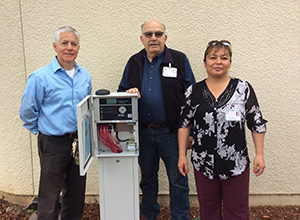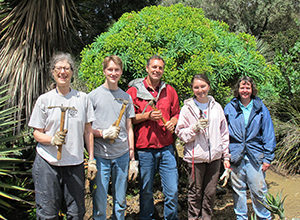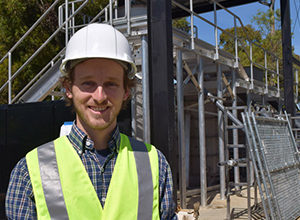Stanford has an extensive history of effective water conservation efforts and in the face of ongoing drought has expanded its sustainable water practices by managing available resources to meet its needs, while preserving ecological systems and vital resources for future generations.
In April 2015, Governor Brown declared a state of emergency and issued an executive order to reduce water consumption statewide. In response, the State Water Resources Control Board adopted emergency water conservation regulations that required institutional potable (domestic) water users like Stanford to reduce consumption by 25% from a 2013 baseline, or to limit irrigation to two days per week. Stanford complied with the regulations by limiting irrigation using potable water to two days per week. While nonpotable water conservation is not regulated by the State Water Board, Provost Etchemendy wrote an open letter to the campus requesting a reduction in the use of nonpotable irrigation water to encourage good stewardship. These actions are still in place, and the campus community has achieved significant savings as a result.
Results
In response to the drought, all Stanford groups have reduced water use substantially.
Collectively, Stanford has reduced potable water use on campus by 49% comparing this water year (July 2015 through June 2016) to a 2001 baseline, despite adding almost 3 million gross square feet to the campus buildings portfolio.
Many customer groups put forth substantial drought-driven conservation efforts in indoor and irrigation practices that resulted in significant reductions in their total consumption compared to pre-drought use. Their efforts resulted in total reductions of 23% for campus indoor water use, 42% for domestic irrigation, and 23% for nonpotable irrigation. The table below summarizes these groups’ results.
Percentage of Water Use Reductions by Major Groups: Calendar Years 2015 vs. 2013

Stanford saw substantial water use reduction in 2015 due to drought response and other conservation actions by all groups on campus. Outdoor water savings came from carefully monitoring irrigation practices, making changes to systems, and transitioning to weather-based irrigation controllers (WBICs). Residential & Dining Enterprises (R&DE) excelled as a water-saving champion – the department upgraded its entire irrigation system to more efficient equipment. Indoor savings resulted from careful monitoring of processes and a concerted effort by faculty, staff, and students to change their behavior to conserve water.

The School of Medicine installed weather-based irrigation controllers
In addition to the drought-triggered reductions, Stanford’s Water Quality, Efficiency, and Stewardship (WQES) team expanded its Water Efficiency (WE) program, developing and implementing measures to further encourage voluntary conservation. Since 2014 WE staff has sent out monthly reports to each major campus customer group to track water usage and promote savings. The reports help to inform campus managers about their group’s water consumption and encourage conservation.
The greatest savings have been achieved by groups taking a holistic approach that includes open communication between area managers and WE staff, the use of smart or weather-based irrigation controllers (for landscape sites), and equipment and fixture retrofits. Additional conservation measures include provision of regular updates on drought conditions and recommendations of ways to conserve on the WE website; a call to action for the campus community, which yielded almost 1,000 pledges to conserve water; and expanded WE rebates for campus residents and groups.
View the campus consumption of potable and nonpotable water since 2001.
Campus domestic water use averaged 1.39 million gallons per day in the 2016 water year, the lowest average since the start of the water conservation program in 2001. In addition to the departmental savings outlined above, water conservation activities this year included the following:
- After a full year with new irrigation equipment, R&DE has reduced its water use by 66%. The School of Medicine (SOM) followed suit and converted nine of its standard irrigation controllers on campus to WBICs, earning a rebate from the WE program. This upgrade is expected to reduce irrigation water use at each site by at least 20% compared to 2013.
- Due to the success of the first phase of the Residential Smart Irrigation Controller Pilot Study with members of Stanford Campus Residential Leaseholders, the WQES team again partnered with OnPoint EcoSystems and the Santa Clara Valley Water District to conduct Phase 2 of the study. Participants in the first pilot saw, on average, a 27% reduction in water use during the first year (July 2014 – June 2015 compared to July 2013 – June 2014), and results from Phase 2 are forthcoming.
- WE staff coordinated with campus facilities to promote the 24-hour Land, Buildings & Real Estate (LBRE) operations hotline as a hub for reporting water waste and leaks so they can be quickly remedied. Call (650) 723-2281 for attention to any leaking taps, toilets, or showers; misaligned irrigation (not watering plants); broken irrigation sprinklers (water shooting into the air); or excessive irrigation runoff (flowing in gutters).
- The WQES team participated in the U.S. Environmental Protection Agency’s national Fix a Leak Week with featured examples of leaks fixed on campus to encourage the campus community to report leaks to the LBRE operations hotline.
- The Office of Sustainability and the WQES team led the Shorter Shower Challenge as part of the 2016 water conservation campaign. During the campaign, in partnership with R&DE, FlowLabs, and student groups, the Wilbur complex dorms had metering equipment installed to track progress.

Earth Day service project volunteers
- WE staff collaborated with LBRE Grounds Services and Land Use and Environmental Planning to organize an Earth Day service project at three of Stanford’s important water-efficient landscapes: the Arizona Garden, the Water Wise Garden, and the Foothills.
- WE staff collaborated with the Bay Area Water Supply & Conservation Agency to host a Tree Care in Drought class. The class provided campus residents with an initial overview of the best management practices for their trees, including watering, pruning, and mulching, as well as checking drought-stressed trees for diseases.
- From January through April 2016, WE staff gave out free water-saving devices and other items, including over 200 shower timers, 50 water conservation bookmarks, 26 hose nozzles, and over 100 items such as pins, decals, stickers, and landscaping signs. The WE program also provided showerheads, aerators, and toilet leak detection tablets.
- The WE program has maintained and updated an interactive map, featured on its website, that details water conservation retrofit projects from 2002 to the present. A variety of sorting parameters allow users to quickly search more than 300 indoor and outdoor projects. The map provides details on the water-efficient equipment installed during retrofit projects, as well as the estimated water savings, when available, and also includes general water profiles for each new building opened since 2007.
Academic Integration

The Codiga Resource Recovery Center is scheduled to begin operations in fall 2016
Two efforts highlight Stanford’s integration of academic/research and operational staff resources. First, the Searsville Alternatives Study, which was directed by a steering committee composed of senior faculty in the Earth Sciences and Civil & Environmental Engineering departments, concluded its work in spring 2015. Its three recommendations for Searsville are now being investigated further and deliberated on by a working group of Stanford staff along with staff from various resource agencies. Second, construction is being completed on the William and Cloy Codiga Resource Recovery Center, which has the primary purpose of testing and demonstrating the scalability of promising wastewater treatment technologies and will serve as an innovation accelerator. The center is scheduled to begin operations in fall 2016.
Looking Ahead
The Water Resources and Civil Infrastructure Group will continue refining projections of future demand and investigating alternative water supplies and sustainable use practices for existing supplies, moving toward development of a campus-wide Sustainable Water Management Plan.
The WQES team will continue to work with students, faculty, staff, campus groups, and residents to promote efficient practices, track water savings, and implement projects that promote water conservation.
